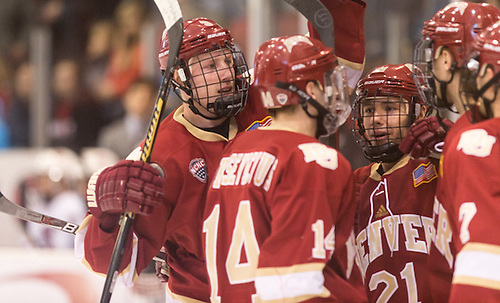
We’re at that time of the year where one thing is on everyone’s minds.
Will my team make the NCAA tournament? Where does it sit in the PairWise Rankings (PWR)?
Those of you that are veterans of the college hockey scene know that it is all about the PairWise Rankings. This is USCHO’s numerical approach that simulates the way the NCAA Division I men’s ice hockey committee chooses the teams that make the NCAA tournament.
Since USCHO began the PairWise Rankings, we have correctly identified all of the teams that have been selected to the NCAA tournament.
Five of the last six years, I am the only prognosticator to have correctly predicted the exact brackets for the NCAA tournament, meaning that I have predicted how the committee thought when putting together the brackets.
With that in mind, it’s time once again to do what we like to call Bracketology, college hockey style. It’s our weekly look at how I believe the NCAA tournament might look like come selection time, using what we know now.
It’s a look into the possible thought processes behind selecting and seeding the NCAA tournament teams.
This is not a be-all, end-all analysis of the bracket. I am trying to give you, the reader, an idea of what the committee might be thinking and not exactly what they are thinking.
This is the next installment of Bracketology for 2017, and we’ll be bringing you a new one every week until we make our final picks before the field is announced on March 19.
If you want to skip the inner workings and get to the results of the analysis, then click here.
Here are the facts:
• Sixteen teams are selected to participate in the national tournament.
• There are four regional sites (East – Providence, R.I.; Northeast – Manchester, N.H.; Midwest – Cincinnati, Ohio; West – Fargo, N.D.).
• A host institution that is invited to the tournament plays in the regional for which it is the host and cannot be moved. The host institutions this year: Brown in Providence, New Hampshire in Manchester, Miami in Cincinnati and North Dakota in Fargo.
• Seedings will not be switched. To avoid undesirable first-round matchups, including intra-conference games (see below), teams will be moved among regionals, not reseeded.
Here are the NCAA’s guidelines on the matter, from the 2015 pre-championship manual:
In setting up the tournament, the committee begins with a list of priorities to ensure a successful tournament on all fronts, including competitive equity, financial success and the likelihood of a playoff-type atmosphere at each regional site. For this model, the following is a basic set of priorities:
1. Once the six automatic qualifiers and 10 at-large teams are selected, the next step is to develop four groups from the committee’s rankings of 1-16. The top four teams are No. 1 seeds and will be placed in the bracket so that if all four teams advance to the Men’s Frozen Four, the No. 1 seed will play the No. 4 seed and the No. 2 seed will play the No. 3 seed in the semifinals. The next four are targeted as No. 2 seeds. The next four are No. 3 seeds and the last four are No. 4 seeds.
2. Step two is to place the home teams. Host institutions that qualify will be placed at home.
3. Step three is to fill in the bracket so that first-round conference matchups are avoided, unless it corrupts the integrity of the bracket. If five or more teams from one conference are selected to the championship, then the integrity of the bracket will be protected (i.e., maintaining the pairing process according to seed will take priority over avoidance of first-round conference matchups). To complete each regional, the committee assigns one team from each of the remaining seeded groups so there is a No. 1, No. 2, No. 3 and No. 4 seed at each regional site.
Given these facts, here is the top 16 of the current PairWise Rankings (PWR), and the conference leaders through all games of February 21:
1 Denver
2 Minnesota-Duluth
3 Harvard
4 Minnesota
5 Western Michigan
6 Boston University
7 Union
8 Massachusetts-Lowell
9t Providence
9t Cornell
11 Penn State
12 St. Cloud State
13 Ohio State
14 North Dakota
15t Air Froce
15t Notre Dame
17t Boston College
24 Bemidji State
Current conference leaders based on winning percentage:
Atlantic Hockey: Air Force
Big Ten: Minnesota
ECAC Hockey: Union
Hockey East: Boston College
NCHC: Denver
WCHA: Bemidji State
Notes
• Bracketology assumes that the season has ended and there are no more games to be played — i.e., the NCAA tournament starts tomorrow.
• Because there are an uneven amount of games played inside each conference, I will be using winning percentage, not points accumulated, to determine the current leader in each conference. This team is my assumed conference tournament champion after applying the tiebreakers.
Step one
From the committee’s report, choose the 16 teams in the tournament.
We break ties in the PWR by looking at the individual comparisons among the tied teams, and add in any current league leaders that are not currently in the top 16. The only teams that are not are Boston College and Bemidji State.
From there, we can start looking at the ties and bubbles in a more detailed fashion.
The ties and bubbles consist of none this week.
We break all of our ties based upon the RPI.
Therefore, the 16 teams in the tournament, in rank order, are:
1 Denver
2 Minnesota-Duluth
3 Harvard
4 Minnesota
5 Western Michigan
6 Boston University
7 Union
8 Massachusetts-Lowell
9 Providence
10 Cornell
11 Penn State
12 St. Cloud State
13 Ohio State
14 Air Force
15 Boston College
16 Bemidji State
Step two
Now it’s time to assign the seeds.
No. 1 seeds: Denver, Minnesota-Duluth, Harvard, Minnesota
No. 2 seeds: Western Michigan, Boston University, Union, Massachusetts-Lowell
No. 3 seeds: Providence, Cornell, Penn State, St. Cloud State
No. 4 seeds: Ohio State, Air Force, Boston College, Bemidji State
Step three
Place the No. 1 seeds in regionals.
No. 1 Denver is placed in the Midwest Regional in Cincinnati.
No. 2 Minnesota-Duluth is placed in the West Regional in Fargo
No. 3 Harvard is placed in the East Regional in Providence.
No. 4 Minnesota is placed in the Northeast Regional in Manchester.
Step four
Now we place the other 12 teams so as to avoid intra-conference matchups if possible.
Begin by filling in each bracket by banding groups. Remember that teams are not assigned to the regional closest to their campus sites by ranking order within the banding (unless you are a host school, in which case you must be assigned to your home regional).
If this is the case, as it was last year, then the committee should seed so that the quarterfinals are seeded such that the four regional championships would be played by No. 1 vs. No. 8, No. 2 vs. No. 7, No. 3 vs. No. 6 and No. 4 vs. No. 5.
So therefore:
No. 2 seeds
No. 8 Massachusetts-Lowell is placed in No. 1 Denver’s regional, the Midwest Regional.
No. 7 Union is placed in No. 2 Minnesota-Duluth’s regional, the West Regional.
No. 6 Boston University is placed in No. 3 Harvard’s regional, the East Regional.
No. 5 Western Michigan is placed in No. 4 Minnesota’s regional, the Northeast Regional.
No. 3 seeds
Our bracketing system has one regional containing seeds 1, 8, 9, and 16; another with 2, 7, 10 and 15; another with 3, 6, 11 and 14; and another with 4, 5, 12 and 13.
No. 9 Providence is placed in No. 8 Massachusetts-Lowell’s regional, the Midwest Regional.
No. 10 Cornell is placed in No. 7 Union’s regional, the West Regional.
No. 11 Penn State is placed in No. 6 Boston University’s regional, the East Regional.
No. 12 St. Cloud State is placed in No. 5 Western Michigan’s regional, the Northeast Regional.
No. 4 seeds
One more time, taking No. 16 vs. No. 1, No. 15 vs. No. 2, etc.
No. 16 Bemidji State is sent to No. 1 Denver’s regional, the Midwest Regional.
No. 15 Boston College is sent to No. 2 Minnesota-Duluth’s regional, the West Regional.
No. 14 Air Force is sent to No. 3 Harvard’s regional, the East Regional.
No. 13 Ohio State is sent to No. 4 Minnesota’s regional, the Northeast Regional.
The brackets as we have set them up:
East Regional (Providence):
14 Air Force vs. 3 Harvard
11 Penn State vs. 6 Boston University
Northeast Regional (Manchester):
13 Ohio State vs. 4 Minnesota
12 St. Cloud State vs. 5 Western Michigan
Midwest Regional (Cincinnati):
16 Bemidji State vs. 1 Denver
9 Providence vs. 8 Massachusetts-Lowell
West Regional (Fargo):
15 Boston College vs. 2 Minnesota-Duluth
10 Cornell vs. 7 Union
Our first concern is avoiding intraconference matchups. We have quite a few in St. Cloud-Western Michigan, Ohio State-Minnesota, Providence-Mass.-Lowell and Cornell-Union.
What can we do about this and take into account attendance at the same time?
Providence in Providence. Makes sense.
East Regional (Providence):
14 Air Force vs. 3 Harvard
9 Providence vs. 6 Boston University
Northeast Regional (Manchester):
13 Ohio State vs. 4 Minnesota
12 St. Cloud State vs. 5 Western Michigan
Midwest Regional (Cincinnati):
16 Bemidji State vs. 1 Denver
11 Penn State vs. 8 Massachusetts-Lowell
West Regional (Fargo):
15 Boston College vs. 2 Minnesota-Duluth
10 Cornell vs. 7 Union
Moving Union to the East. In this case, I make a few swaps, to get Union to Providence, BU to Manchester and Western Michigan to Cincinnati.
East Regional (Providence):
14 Air Force vs. 3 Harvard
9 Providence vs. 7 Union
Northeast Regional (Manchester):
13 Ohio State vs. 4 Minnesota
12 St. Cloud State vs. 6 Boston University
Midwest Regional (Cincinnati):
16 Bemidji State vs. 1 Denver
11 Penn State vs. 5 Western Michigan
West Regional (Fargo):
15 Boston College vs. 2 Minnesota-Duluth
10 Cornell vs. 8 Massachusetts-Lowell
OK, what else?
Swap Cornell with St. Cloud.
East Regional (Providence):
14 Air Force vs. 3 Harvard
9 Providence vs. 7 Union
Northeast Regional (Manchester):
13 Ohio State vs. 4 Minnesota
10 Cornell vs. 6 Boston University
Midwest Regional (Cincinnati):
16 Bemidji State vs. 1 Denver
11 Penn State vs. 5 Western Michigan
West Regional (Fargo):
15 Boston College vs. 2 Minnesota-Duluth
12 St. Cloud State vs. 8 Massachusetts-Lowell
Now we have to take care of Ohio State-Minnesota.
We swap Ohio State and Boston College.
East Regional (Providence):
14 Air Force vs. 3 Harvard
9 Providence vs. 7 Union
Northeast Regional (Manchester):
15 Boston College vs. 4 Minnesota
10 Cornell vs. 6 Boston University
Midwest Regional (Cincinnati):
16 Bemidji State vs. 1 Denver
11 Penn State vs. 5 Western Michigan
West Regional (Fargo):
13 Ohio State vs. 2 Minnesota-Duluth
12 St. Cloud State vs. 8 Massachusetts-Lowell
I would love to get Ohio State to Cincinnati, but that can’t be done because we’re protecting the No. 1 seed with the only team NOT in the Top 16 at the moment.
So that would be the bracket.
Unless we make a three-way swap of matchups.
Ohio State-UMD to Cincinnati, Bemidji State-Denver to Manchester and BC-Minnesota to Fargo.
East Regional (Providence):
14 Air Force vs. 3 Harvard
9 Providence vs. 7 Union
Northeast Regional (Manchester):
16 Bemidji State vs. 1 Denver
10 Cornell vs. 6 Boston University
Midwest Regional (Cincinnati):
13 Ohio State vs. 2 Minnesota-Duluth
11 Penn State vs. 5 Western Michigan
West Regional (Fargo):
15 Boston College vs. 4 Minnesota
12 St. Cloud State vs. 8 Massachusetts-Lowell
Intriguing isn’t it?
So with these two thoughts in mind, I am not going to make a prediction this week. I will leave it as is and let you debate about how it should be done.
See you here in a few weeks for the next Bracketology.
Here’s a summary of everything that we have covered.
This week’s brackets
East Regional (Providence):
14 Air Force vs. 3 Harvard
9 Providence vs. 7 Union
Northeast Regional (Manchester):
15 Boston College vs. 4 Minnesota
10 Cornell vs. 6 Boston University
Midwest Regional (Cincinnati):
16 Bemidji State vs. 1 Denver
11 Penn State vs. 5 Western Michigan
West Regional (Fargo):
13 Ohio State vs. 2 Minnesota-Duluth
12 St. Cloud State vs. 8 Massachusetts-Lowell
OR (You decide)
East Regional (Providence):
14 Air Force vs. 3 Harvard
9 Providence vs. 7 Union
Northeast Regional (Manchester):
16 Bemidji State vs. 1 Denver
10 Cornell vs. 6 Boston University
Midwest Regional (Cincinnati):
13 Ohio State vs. 2 Minnesota-Duluth
11 Penn State vs. 5 Western Michigan
West Regional (Fargo):
15 Boston College vs. 4 Minnesota
12 St. Cloud State vs. 8 Massachusetts-Lowell
Conference breakdowns
NCHC — 4
Hockey East — 4
ECAC Hockey — 3
Big Ten — 3
WCHA — 1
Atlantic Hockey – 1
Movement
In: Ohio State
Out: North Dakota
Last Week’s Bracket
East Regional (Providence):
14 Boston College vs. 3 Harvard
11 Union vs. 8 Providence
Northeast Regional (Manchester):
13 Cornell vs. 4 Minnesota
12 St. Cloud State vs. 5 Boston University
Midwest Regional (Cincinnati):
15 Air Force vs. 2 Denver
9 Massachusetts-Lowell vs. 7 Western Michigan
West Regional (Fargo):
16 Bemidji State vs. 1 Minnesota-Duluth
10 North Dakota vs. 6 Penn State


